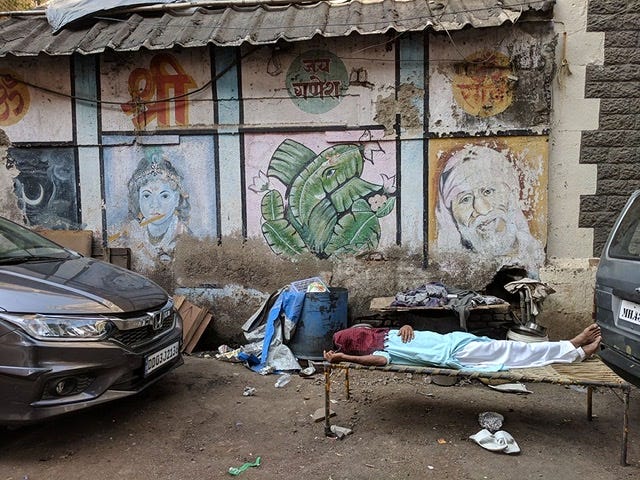There’s an old essay on Bandra’s Zenzi written by Juhi Pande — Last Call. It is one of my favourite pieces written about Bombay, or at least a slice of it.
This October will mark 10 years since Zenzi shut down. Back then it was already on its last legs. The scene had shifted to Blue Frog. Then music gave way to comedy. The pubs and clubs, by the end of it, went back to their chauvinist roots of bouncers and bad music and sad food, served in the name of cheap booze.
In February, as I tried to get this second season of Daak going, I wrote in one of my drafts:
… I mean I write this sitting in Bombay where a whiff of winter passed us three days ago. And all the clothes for the imagined cold were out. These clothes have laid low since a year. They have come out to the streets both jittery and hopeful, like prisoners on parole. Yet, despite the disuse, despite a sense of a new start, they have all aged.
Bombay nights have aged just the same.
New and wholly unsuitable ideas, with run of the mill provisions operate in its name. The city needs something new and fresh and open. And against all hope - cool.
“When lockdown began, ... I thought of all the friends I would not see for some indefinite period. I thought of the pubs and people I had sought refuge in, in times before. Paintings of pubs became the refuge more intensely, now; I finished the larger paintings, in those first early weeks, aware as I did so that they now represented, accidentally, a whole new kind of nostalgia. They were everything I lost and longed for, those I loved.”
The Underground Cafe by artist and writer Christiana Spens.
Public space is scarce in Bombay. I’d correct that. Space is scarce in this city. Home thus isn’t a leisure it ought to be for many. Our old haunts offer what open spaces ought to have, even if at a price. And so these third houses were you could just be, weren’t just a welcome break, but a necessity.
The alternative to them were the roads. At the right places, the city streets are a joy to walk or just be. And sometimes that’s all the hangout you needed.
Take the train, meet a friend and walk to some place to grab a grub, or horror - a book. Comment upon each other’s personal history with that street, comment upon the passers by, and the residents and their residences. Or you just gather around a local point of sanity. And then you consider the unevenness of time spread in front of you. You see how this city lives in multiple centuries at once.
(In Reading Bombay Through Arun Kolatkar’s Kala Ghoda Poems by Saranya Subramanian speaks about the other unevenness that’s more prominent — the collateral damage of a city plagued with development).
I think then about these pockets, the streets and bars we called home in some manner, as a collective. What all would have this past year changed about them?
And as the city continues its constant gentrification, how much will change in the coming decade?
In Pete Hamill’s essay on how New York has changed, he points:
The city is wealthier and healthier than when I was young. But—hey, in New York there’s always a but—its architectural face is colder, more remote, less human, seeming to be sneering. In Manhattan the new superthin, supertall buildings are blocking the sky, casting long, arrogant shadows on streets once caressed by sun. And those streets are jammed with traffic, like a welded pop art sculpture made of paralyzed cars, imperious limousines, honking yellow taxicabs, and fat, grunting delivery trucks.
As the old haunts of my youth either shutter down and a new modern Bombay takes shape against all wishes, it carries the same fate with it - less human, more remote, seemingly sneering.
Or maybe not.
Bombay lends you nostalgia, but it isn’t something you can afford. In a city that changes shape every minute, you remark on the past only as a point of reference to what’s about to come. In the past year and a half, what was about to happen might have already happened, that we, the aged clothes of winter didn’t bear witness. The city moves on and other newer haunts will carry the people into the city’s future.
Bombay has always had beautiful skies. On good days it gathers over this island like an aura. It has that emotional intensity to it, flair and drama. The crowds throng to spots that gives us the full extent of the city’s sky. But for the privileged amongst us, we had our private spots. We were as much a fixture of the place as its tables and chairs. And the city has had a litany of such spots that have come and gone.
In Last Call, Pande puts words to this emotional aura of these places that pulls us:
The magic of these spots, which are ephemeral by nature, can be difficult to describe to the uninitiated. But when you find one of these enchanted corners, you know you’re exactly where you need to be.
À bientot.
P.S.
This GQ piece on Zenzi captures that era in more detail, but there’s a charm that’s missing.
Pete Hamill passed away last year in August. He was a luminary in the field of journalism. Here’s an interview of him breaking down the craft of writing.
I recently went back digging into the archives of The Daily Pao and listened to this Paodcast on the ‘eating haunts’ of Matunga and Mahim.




Those sweaters in Bombay deserve an entire Daak to themselves